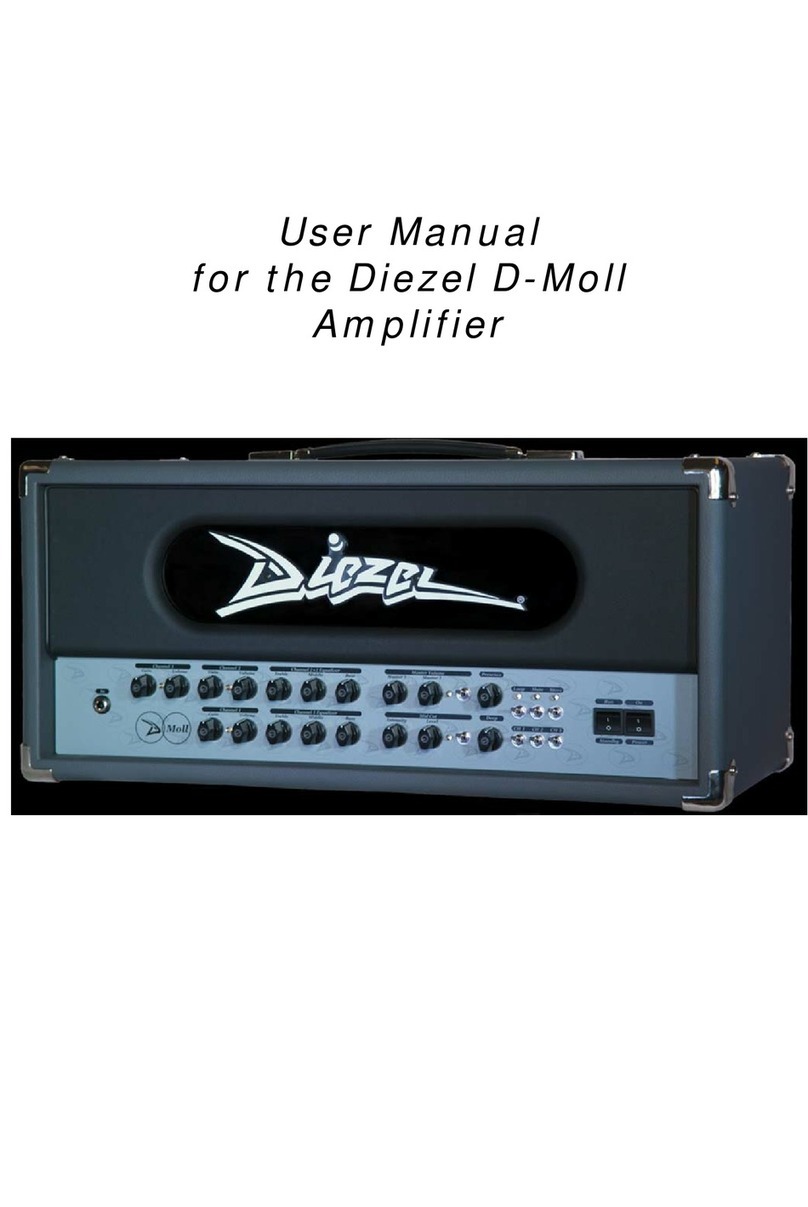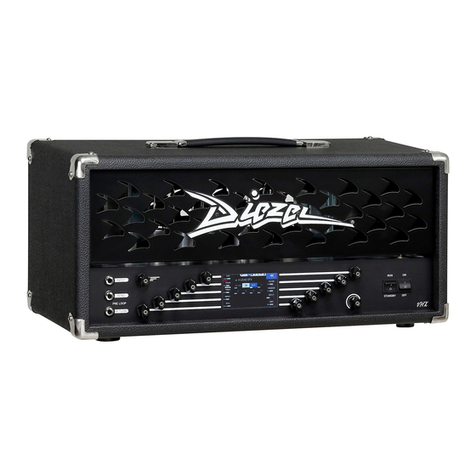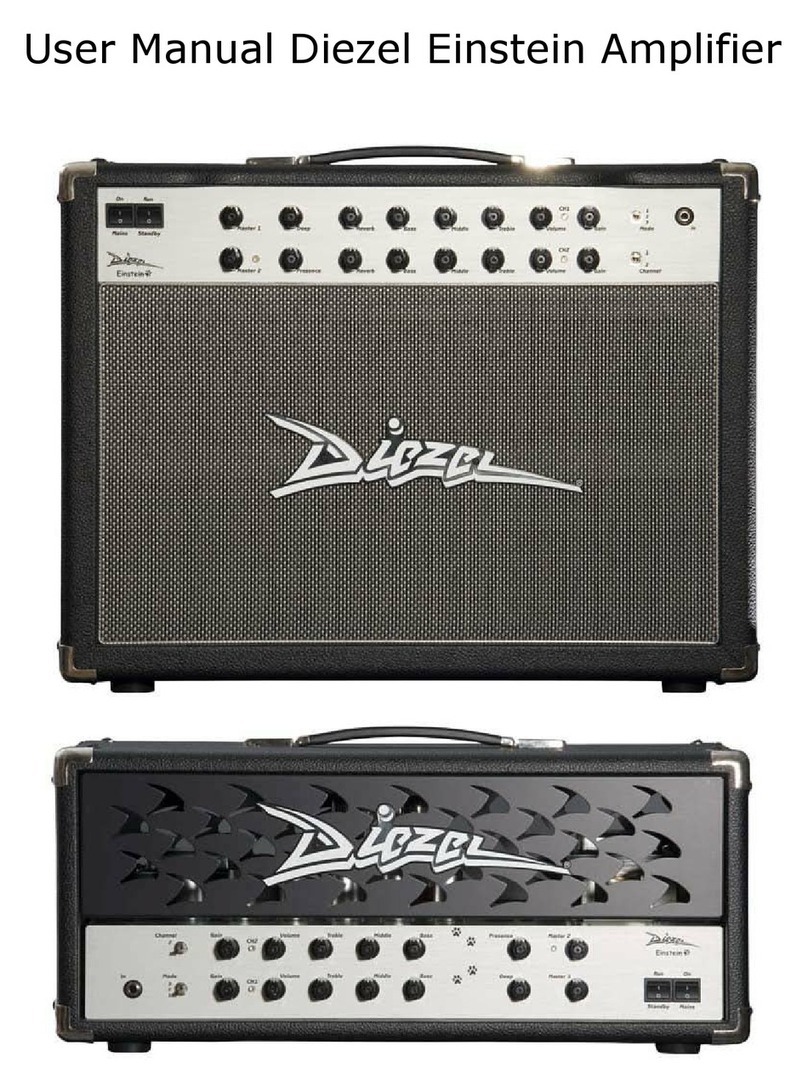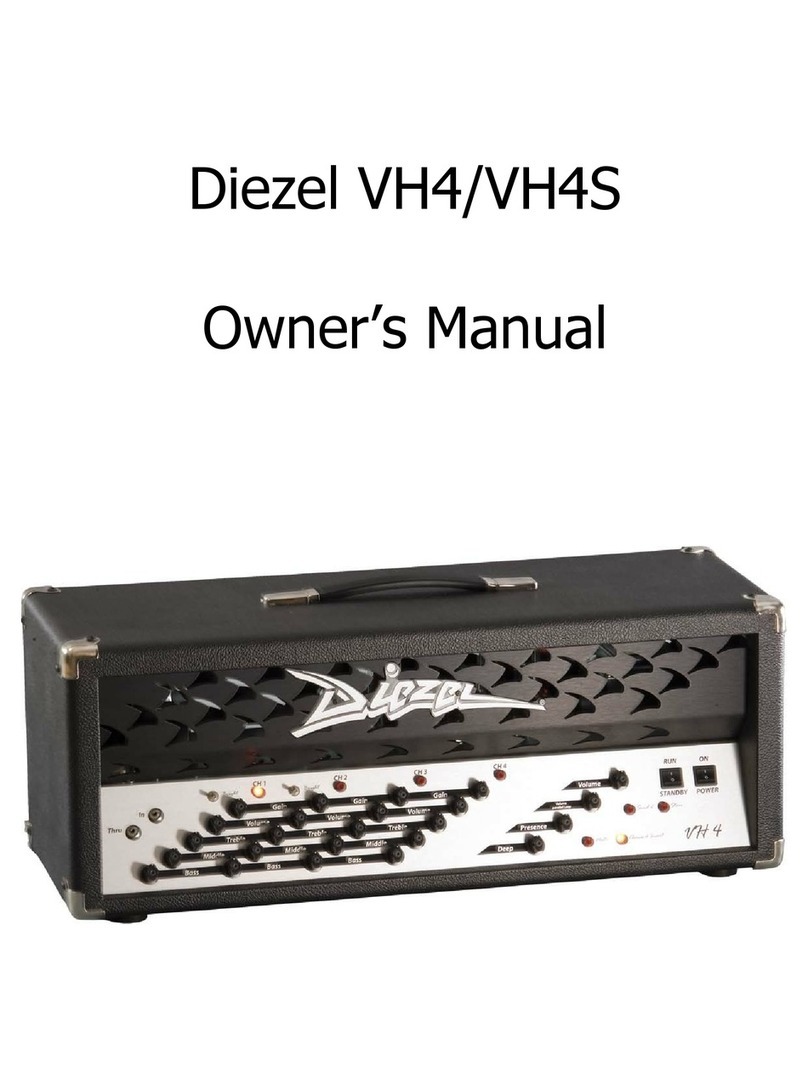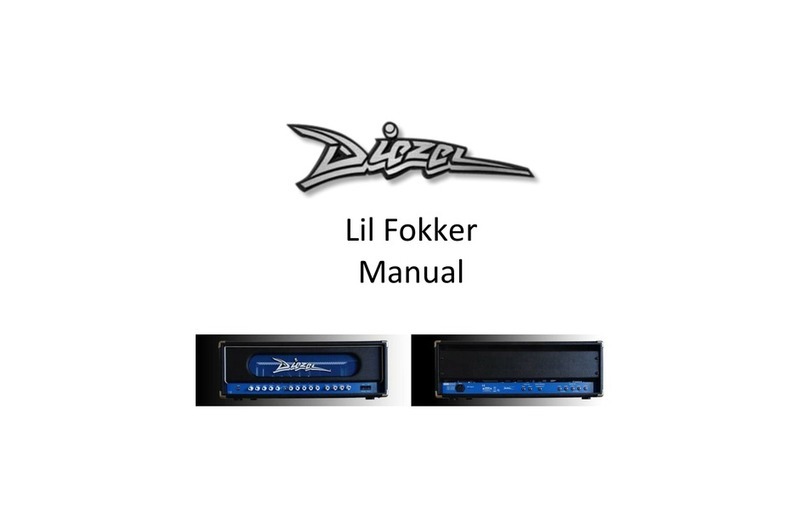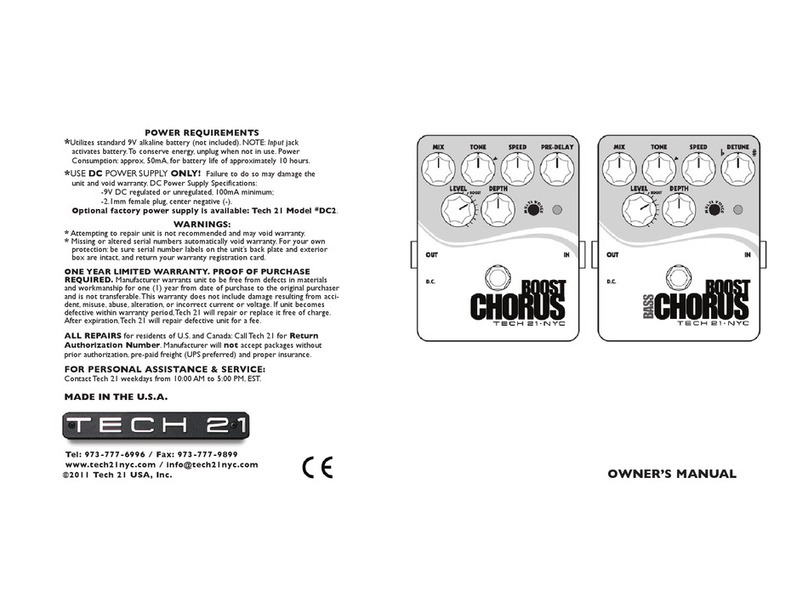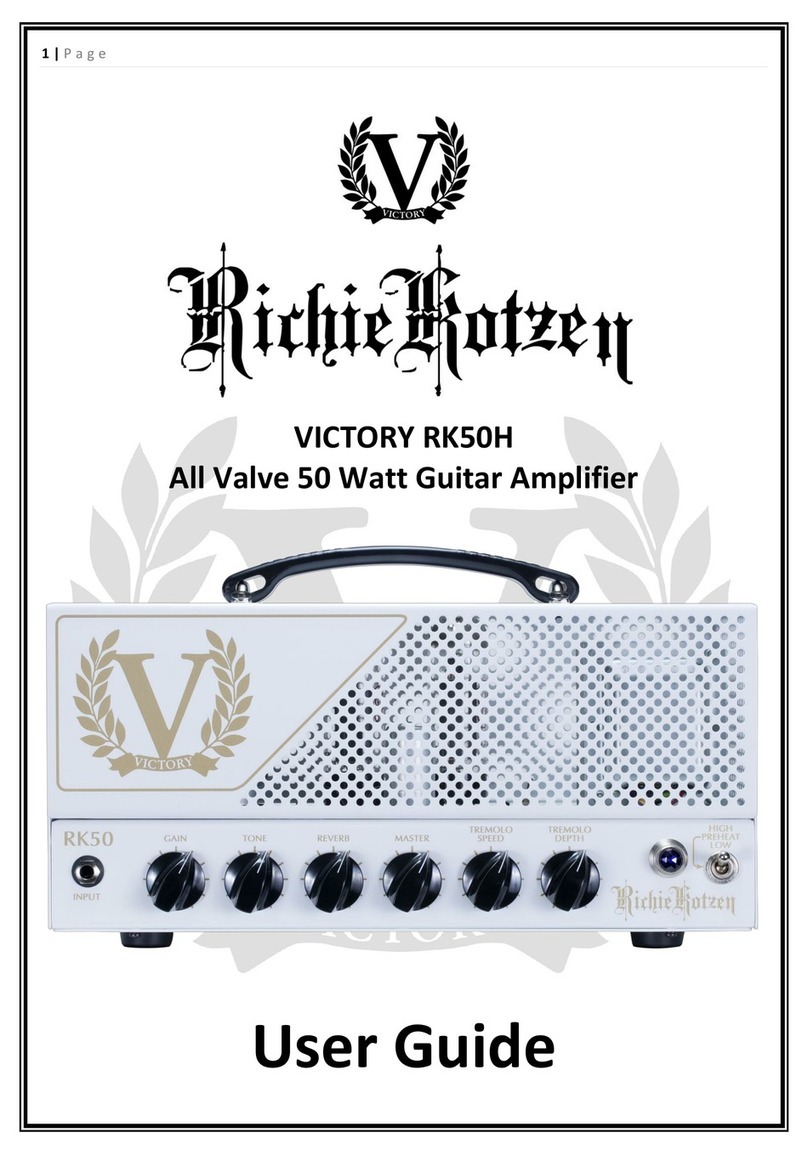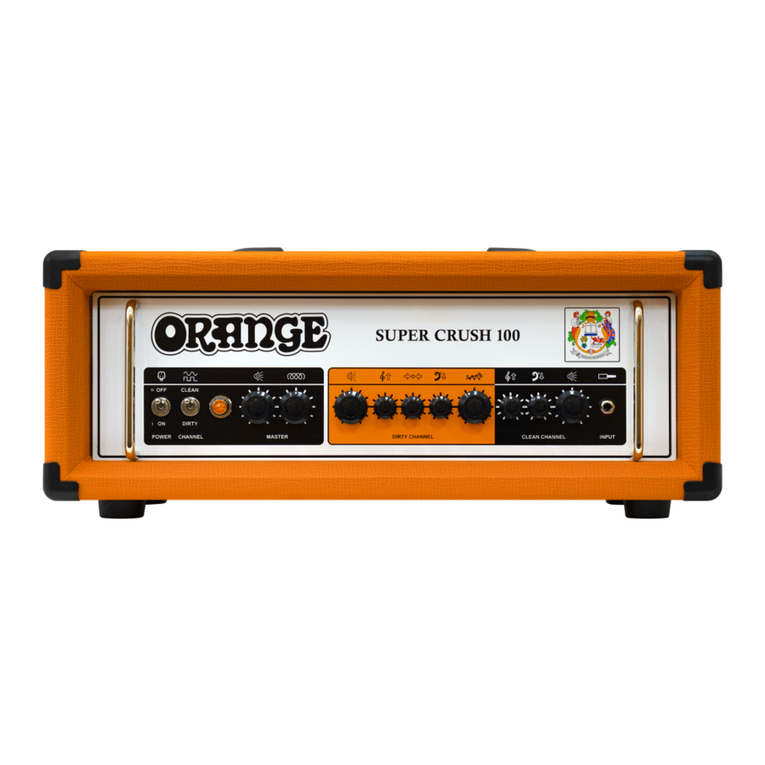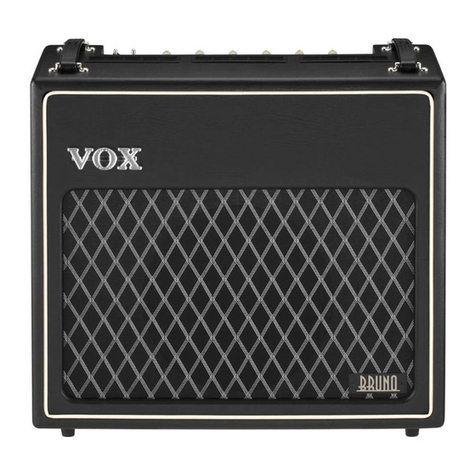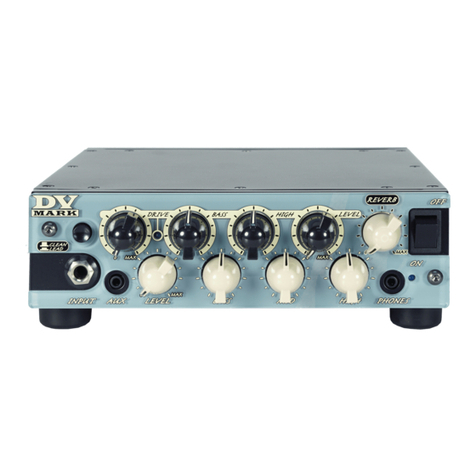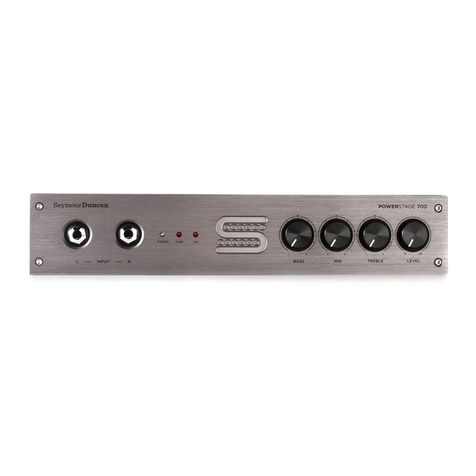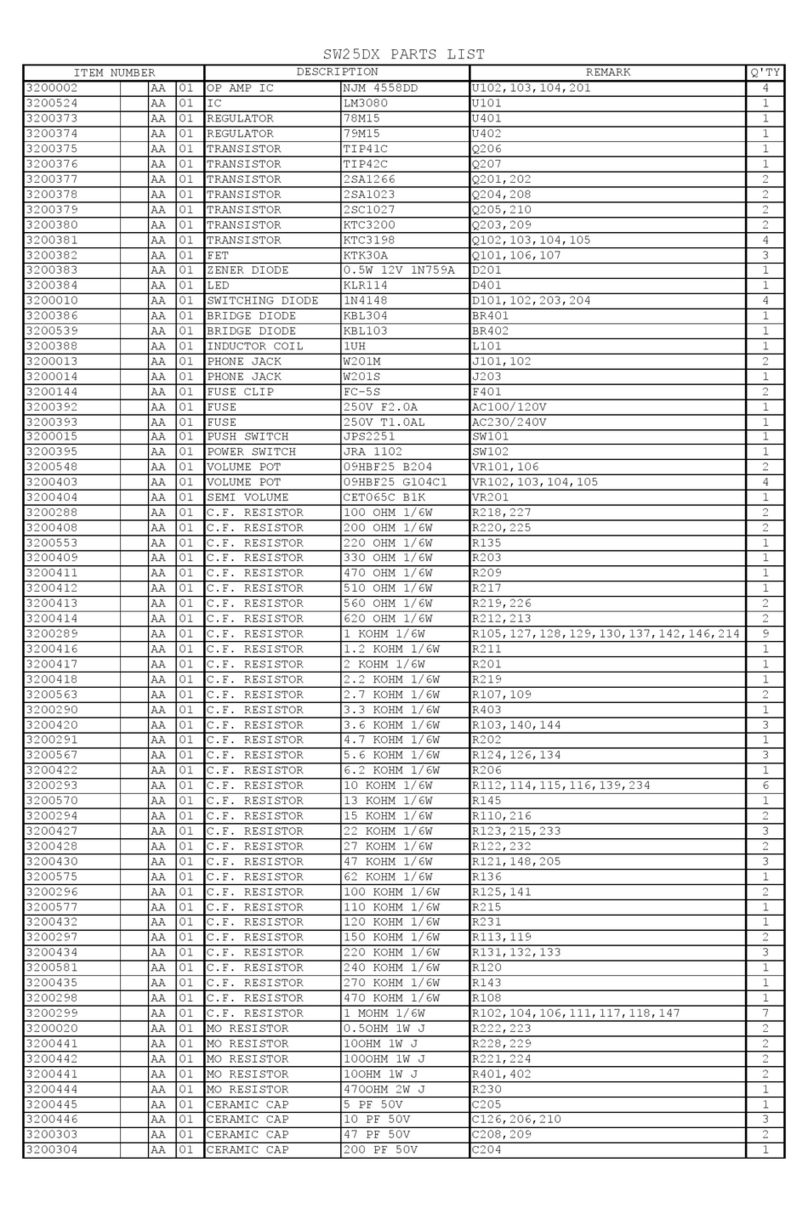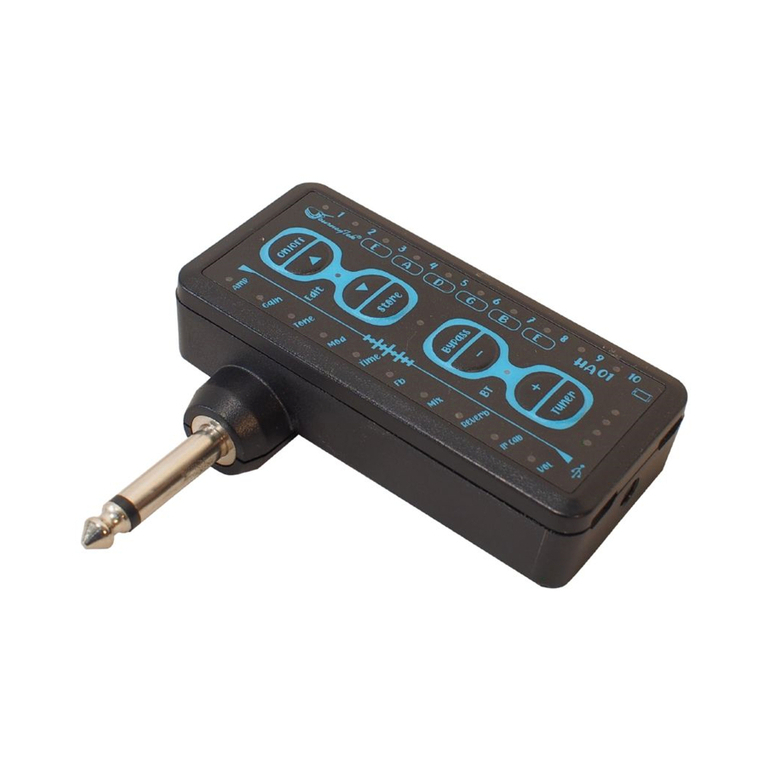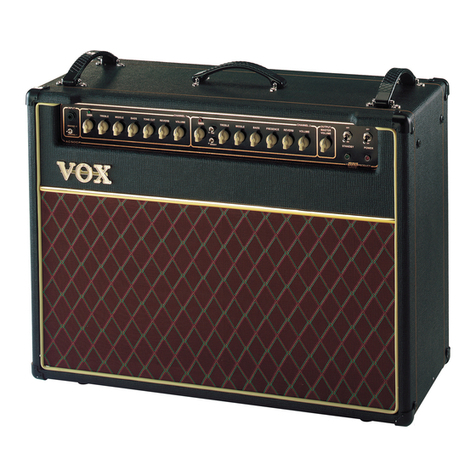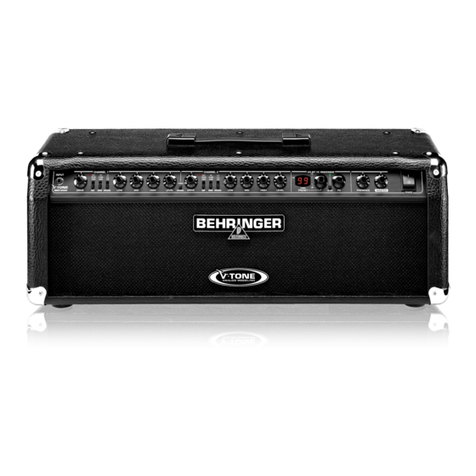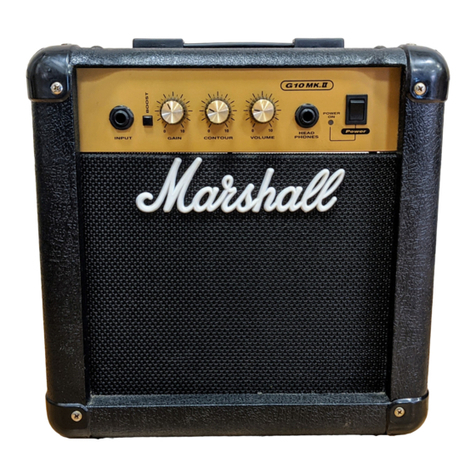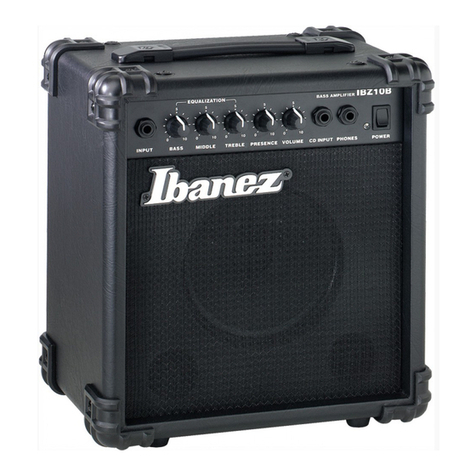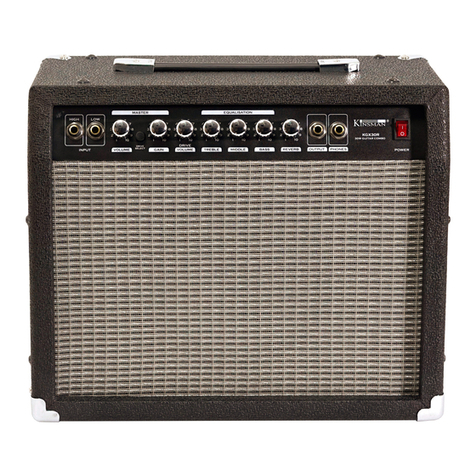Diezel Schmidt User manual

User Manual
Diezel Schmidt Amplifier

Table of Contents
Chapter One: Safety and Warranty
1.1 Safety Warnings
1.2 Warranty information
Chapter Two: Using your Schmidt
2.1 Mains Connections, power and Standby
2.1.1 Mains/connect to power outlet
2.1.2 Power up, Warm up, Standby off
2.1.3 Power tube caution
2.1.4 Operating Temperature
2.1.5 Power Tube Information
Chapter Three: Peripheral Connections
3.1 Front Panel Connections
3.1.1 Signal In
3.1.2 Cable ABC
3.1.3 Cable Selection
3.2 Rear Panel Connections
3.2.1 Send/Return Loop
3.2.2 Parallel or Serial?
3.2.3 Reasons for Dynamic Losses in the Effects Loop
3.2.4 Compensated Out
3.2.5 Speaker Connections
3.2.6 Switching
Chapter Four: The Two (and a half) Pre-Amplifiers
4.1 Pre-Amplifier Duties
4.1.1 Channel One
4.1.2 Channel Two, Channel Three
4.2 Pre-Amplifier Tubes
4.2.1 Noise and Microphonics
Chapter Five: Power Amplifier
5.1 Tone and Volume of the Power Amplifier
5.1.1 Channel volumes
5.2 Power Amplifier Tubes
5.2.1 Function
5.2.2 Selection
5.2.3 Life Span

Chapter Six: Functions and Switches
6.1 Manual Channel Selection
6.2 External Switching
Chapter Seven: Maintenance and Cleaning
7.1 Cleaning
7.2 Care
7.3 Tube Change
7.4 Fuses

Chapter One: Safety and Warranty
1.1 Safety warnings
We would like to stress the importance of the following points, for reasons ofyour
personal safety, product longevity and product liability.
Do not use the Amplifier in or near wet locations
Do not store the Amplifier in damp or wet locations
Do not operate the Amplifier on voltages other than those designated on the rear
panel of the amplifier.
Do not open the panels of the amplifier. No user serviceable parts inside.Your
Schmidt operates on very high internal voltages, which may still bepresent after the
Amplifier has been turned off and disconnected for awhile.
Do not use the Amplifier for anything other than its designed purpose: To Amplify
Electric Guitar Signals
Do not use fuses other than those intended and specified for the Amplifier
Do not use 2-conductor extension cords or anything other than 3-polegrounded
outlets for this appliance. Your life may depend on it!
Please observe the following points when transporting your Schmidt:
Schmidt is a tube-powered amplifier; therefore it is sensitive to shock especially
after playing the amplifier for a while. Please store and transport your amplifier
gently and try to avoid extreme temperatures, which might produce condensation,
resulting in moisture on internal components. Usually a 60 Minute
acclimatizationperiod is sufficient to ensure safe operation. The amplifier should be
stored in a controlled environment, and it should be transported in a suitable flight
case. Make sure the amplifier gets transported in itsnormal operating position, not
upside down or on its side. The Schmidt’s design incorporates a very potent power
amplifier. It is configured to deliver satisfying guitar tones at most volume levels.
In its normal operational volume level (75-80dB) it will provide beautiful tones with
very little coloration. For reasons of your own safety, please do not run the
amplifier above these levels for extended periods of time without wearing a hearing
protection. Hearing Loss is a long-term ailment, and is not normally curable.
1.2 Warranty
5 years to the original owner with proof of purchase. Power Tubes and Pre Amp
tubes are covered for 3 months to the original owner. The amps will be tracked via
both Diezel USA and Diezel Germany recorded sales beginning 1/20/2009. ALL
REPAIR WORK MUST BE DONE BY A DIEZEL CERTIFIED TECHNICIAN. Not following
this procedure will VOID WARRANTY. This will ensure the the original owner and us
at Diezel Amplification that the work is done correctly and that there is knowledge
of what is going on out there with each amp. To any second owners or more, there
is no warranty coverage nor is a warranty transferable. (This policy is no different
then before). Of course we at Diezel are happy to serve people who purchase their
amplifier on the used market should your amp ever need servicing. Parts and labor
charges will occur for our work on your amplifier as usual.
If you purchased your amp before 1/20/2009 you are categorized under the same
guidelines as when you purchased your amp (Lifetime warranty for the original
owner, 1 year transferrable warranty).

Chapter Two: Using Your Schmidt
2.1 Mains Connections, Power and Standby
2.1.1 Mains/Connection to Power Outlet
Please make sure that both switches (Power and Standby) are in the off position
before connecting to the mains circuit. Verify line voltage before connecting the
power cord. Never start Schmidt without connecting speakers to the proper
terminals. (See 3.2.5)
2.1.2 Power up, Warm up, Standby off
First, turn the Power switch to on (facing up). The indicator light will turn on. This
starts the tube heating process. After about 40 seconds, the tubes should be
sufficiently heated for normal operation. Your Schmidt is then ready for operation
and the standby switch can be turned to “run” (also facing up). Premature
activation of the standby switch will lead to unnecessary tube stress and
subsequent reduction of the power tube’s life span.
2.1.3 Power Tube Caution
Tubes are electronic components that function only with vacuum intact and under
very high operating temperatures. Each tube has one or more heating filaments,
much like a light bulb. These filaments heat up the anode of the tube. If you switch
the standby switch to the “run” position before these anodes have reached their
operating temperature (when the anode surfaces are not heated evenly), this
causes undue stress to the tubes and their related components inside the amp.
Always give the amp its much needed warm-up time, even if musical inspiration
hits you with a full force.

2.1.4 Operating Temperature
It will take a little more time after warm-up until everything inside the amp is
working in sync and to its fullest potential. A trained ear will notice a slightly
warmer tone and better complexity in tone after playing the amp for a short while.
It’s like stretching before exercising.
2.1.5 Power Tube Life
The power tubes of your amplifier are subjected to a certain aging process. Once
signs of aging, such as unreliability or unusual noise, are detected, we suggest that
you replace both power tubes at once. Matched tube sets age relatively evenly, so
our experience suggests. This means that if one goes, the others are not far from
meeting the same fate. The aging process manifests itself by a depletion of a thin
layer of wolfram on the anodes. This can take anywhere from 6 month to 3 years,
depending on the amount of use of the amplifier.
Chapter Three: Peripheral Connections
3.1 Front Panel Connections
3.1.1 The input jack (“IN”)
The input jack receives your Electric Guitar signal by means of a shielded guitar
cord with 1/4” mono style plug.
Your guitar cord is an important part of your signal chain and its quality and
construction type clearly affect the overall tone of your rig. Try and buy the best
quality guitar cord that you can or want to afford. Call us if you have doubts and
need recommendations. This is where the smart “weak link” comment comes in.
3.1.2 Cable ABC
Some cords and cables sound very neutral; others color the sound spectrum and/or
attenuate high frequencies due to capacitance inside the wire and the shield. What
are we talking about? OK. A capacitor is used in electronic crossovers, amongst
other things, to divide low and high frequencies. Capacitance in a cable cuts your
guitar’s high end to a certain degree. Generally, the longer of a cord you use, the
more of the cord’s inherent characteristics will be audible.

3.1.3 Cable Selection
In certain circumstances, it is desirable to match a guitar cord to a specific
instrument. One may use the otherwise undesirable qualities of a cord to one’s
advantage, if one has the time and patience to experiment with different cords and
guitars. This should be done while playing with your band, or while recording.
Sometimes it is difficult to tell a component’s true advantages until it is used in the
right context. A guitar that has very piercing highs could theoretically be tamed
down somewhat by using a long guitar cord that offers some high-end attenuation.
The loops of your Schmidt send signals at higher levels and impedances, which
makes this section of wiring less sensitive. You should still use reliable and good
quality wiring for all loops.
3.2 Rear Panel Connections
3.2.1 Send/Return Loop
The system consists of a loop which can be run either in series or in parallel with
the signal. Use good quality cables to run your fx unit. Turning the “Mix” pot to
100% means that the loop is working in series – all the signal goes out of Schmidt,
thru your fx unit and back to the amp. Using lower settings of the “Mix” pot will
increase the original, unaffected signal of Schmidt. Setting the Mix pot to 0 results
(even if the amp is hooked to a fx unit) the original signal. Good results with delays
and reverbs can be achieved by setting the Mix-pot to 20-30% - and (!) setting the
fx unit (level) to full wet. If you don’t do that, you may run into phasing issues,
which sounds strange.

3.2.2 Parallel or Serial
Which is better for you? Read on.There are 2 ways to handle effects signals. The
serial loop interrupts the signal path of the Schmidt and the signal is sent to the
processor, becomes processed, then sent back to the serial return into the power
amp. Digital effects units often digitize this signal once received, then process the
signal, convert it back toanalog, then send it to the amp. This is called ADA (analog
digital analog) conversion. It is necessary for digital effects units digitize your guitar
signal sothat the processor can read and understand signal. Your tubes, however,
need an analog signal to operate, so the processor converts the signal back to
analog before it goes back to the amp. Generally, even in highest quality effects
processors, this causes a change in the original signal, typically a loss of tonality
and warmth, also noticeable as a “harder” sound. When you use the serial loop
foran effects unit like this, then your signal will have been ADA converted at least
once. Tone junkies and vintage freaks alike will more than likely have hives
developing by now. But - as always, there is a better way. Use the Parallel loop and
the Mix control in the rear determines how much effect signal is being added to the
original signal, which now still flows through the amplifier. There is always an
analog connection between the send and return jacks; a parallel loop! Important:
You must set the mix control on the effects unit to 100% wet when using the
parallel operation mode of the loop. Otherwise there will be nasty phasing problems
resulting in unsatisfactory tone. The signal portion that is unaffected by the mix
control in the effects unit would reach the amplifier at a different time due to the
cabling, and cause phasing cancellations.
3.2.3 Top 5 Reasons for dynamic losses in the effects loop
Many different factors can be responsible for loss of dynamics, aside from those
mentioned in 3.2.2 (ADA conversion). A vital point that often leads to frustration is
a maladjusted output level of an effects unit. If the output level is too high, the unit
will cause unwanted distortion in the power amp. If it is too low, then the rig
will not sound punchy and might get lost in the band sound. When used in the
serial loop, the output of the effects unit determines the ultimate drive signal
strength of the power amp. The output level should be matched to give the best
possible sound with all channels without over driving the power amp section.
(Unless this is desired for power amp distortion) Headroom adjustments of 10% are
usually sufficient.

3.2.4 Compensated Out
A frequency corrected signal will leave this jack if you connect it to a mixer or
recording device. Use it to quietly compose or send an auxiliary signal to a console
etc. The comp out is located after the pre- and power amp, so it is a must that the
amplifier is running either with a speaker or a loadbox (THD HotPlate or similar).
3.2.5 Speaker Connections
There are 5 speaker outputs available on the rear panel. They are labelled
according to the intended impedances:
16 Ohm: connect any 16 ohms guitar cabinet to this jack.
8Ohm: connect a single 8 ohms guitar cabinet or two 16 ohms guitar cabinets.
4Ohm: connect a single 4 ohms guitar cabinet or two 8 ohms guitar cabinets.
WARNING: Although the Schmidt amplifier has 5 speaker outputs never attempt
to connect more speakers than rated. The safe combinations are 1x16 Ohm, 1x8
Ohm, 1x4 Ohm, 2x16 Ohm or 2x8 Ohm. Any other speaker configuration may
stress the power amplifier section and in extreme cases may lead to valve and/or
output transformer failure.

3.2.6 Switching
Included with your carton a proprietary footswitch shipped with your amp. Hook a
standard mono guitar cable (instrument or speaker, included) between the
footswitch and the FS5S-jack on the back of your amp.
The footswitch controls all channels, the loop and the reverb.

Chapter Four: Two (and a half) Pre-Amplifiers
4.1 Pre-Amplifiers and their Jobs
The Diezel Schmidt comes equipped with 2 different and totally independent
preamps each with its own Reverb pot. This allows the artist to play through nearly
all musical-styles without having to make major changes to his/her amplifier. The
preamps are voiced to deliver the most wanted guitar tone flavors: Clean, Crunch,
Heavy, Lead. This design concept delivers stellar guitar sounds with excellent
playability, warm dynamics and razor sharp equalization possibilities. The tone
controls work in an unusually wide range, so a little adjustment does quite a lot. As
with so many things, less is often more. We suggest you start exploring the
channels with all controls set to 12:00 o’clock, and the channel volume just slightly
cracked open. (To avoid hearing damage)
4.1.1 Channel One (low to medium gain)
Clean Tone is a very sensitive subject, because there are so many different ideas
on how a clean amp should sound like. Clean tonal textures require much higher
dynamic range than distorted sounds. From hard and percussive sounds to soft,
warm, and blossoming tone. Schmidt was designed to offer as many of the clean
varieties as possible. Your choice of guitars and pickups will have a large part in
this equation. The more you crank the volume of this channel, the more you will
add poweramp warmth to your sound.
.
4.1.2 Channel Two (crunch, heavy)
This channel is voiced for single notes, or for heavier rhythm guitar. Due to its
slight midrange accent and very high gain, it possesses a good punch, will play with
ease, and gain authority to rule any stage, or studio. The“less is often more” rule
applies here also.
Channel three shares the reverb and equalizing section with channel 2, it has
separate gain and volume pots to carry the player from channel 2’s crunchy
spectrum into more singing leads.

4.2 Pre-amplifier Tubes
The pre-amps are equipped with 12AX7 tubes in all positions. The pre-amp tubes
are not designed to produce high power output. Therefore, their life expectancy is
much higher than that of the power amplifier tubes.This is not to undermine their
utter importance in overall sound and response ofthe amplifier. Also, annoying
defects like crackling noises and low dynamics are directly related to defective pre-
amp tubes. Like all other tubes, 12AX7 tubes come in many different gain stages,
and offer a wide variety of tonal behavior. Our choice for production was made to
ensure a wide variety of tones, with low noise and good reliability.
4.2.1 Microphonics and Bad Noises
The overall performance of pre-amp tubes is easily influenced by external
mechanical factors. Malfunction in these external components will manifest
themselves by a sudden, high-pitched feedback sound. The input stage is especially
suspect to these phenomena. If one encounters microphonic tube behavior, then
the first tube should be checked as a rule. Pre-Amplifier tubes can also cause a
hum or other bad noises, like crackling or ticking.

Chapter Five: Power Amplifier
5.1 Tone and Volume of the Power Amplifier
5.1.1 Channel Volume
As the name suggests, this controls the overall, volume of the amplifier’s channel.
The more the channel volume is increased, the higher the rate of power amp
warmth (until power amp distortion is achieved) will be.
5.2 Power Amplifier Tubes
5.2.1 Function
As the name suggests, the power amp section is the part of the amplifier that
produces output power, measured in watts. Preamp signals are sent to the
poweramp(s), which amplifies this signal to a level that is acceptable for
loudspeakers. Guitar amplifiers utilize several different types of power amps, which
differ in output power and tone. We chose the tube type power amplifier for its tried
and true performance and familiar tonal behavior.
5.2.2 Selection
Diezel Co. installs the most reliable and best sounding tubes that are currently
available in sufficient quantities. So it is possible that tube brand and tube type will
change during production. You can fine-tune your Schmidt by having different type
and brands of tubes installed, and because Schmidt is working in Class A operation
mode, there is no need to rebias the amp. Just let the tubes cool down and feel free
to try what you prefer: 5881, 6L6, 6V6 (we’re suggesting to use JJ 6V6S tubes) and
so on.
5.2.3 Life Span
Power tubes last 1 to 3 years, depending on care, volume and frequency of use
ofthe amplifier. If you use your amp only once a month, then the tubes will last
much longer. Really. We have heard tubes that are over 10 years old, but it was
not a good thing. Tubes age very slowly; slow enough for the artist to get used
tothe changing tone.

Chapter Six: Layout of Controls
6.1 Manual Channel Selection
On the left of the pots are the switches for the channels and the loop on/off switch.
Each switch also has an LED indicator, the loop LED on the left of the switch, the
channel’s LED are located between the pots of each channel.
.
6.2 Switching
If you should prefer to use Schmidt inside a more complex rig, then Diezel provides
three switching jacks on the back of the amp (labelled “reverb”, “channel 3/loop”,
“channel 1/2”). If you hook a midi switcher to these jacks, make sure that the later
two need stereo cables while the first jack can be operated with a mono cable.

Chapter Seven: Maintenance and Cleaning
7.1 Cleaning
Never use anything wet to clean the amplifier, any amplifier. Usually, it issufficient
to wipe down the outside of the amp with a slightly moist cleaning rag. Do not use
abrasive cleaning chemicals. Sometimes a vacuum cleaner can be usedto remove
dust and dirt from nooks and crevices. Do not remove the chassis from the housing
to clean the amp; the inside of your amp carries dangerous Voltages.
7.2 Care
Be gentle with this Amplifier. Any mechanical shocks, extreme
temperaturechanges, damp environments, and other extreme conditions (dust,
wind) cansubstantially shorten tube life. In some cases, even the amplifier life. Do
not block the air circulation grilles in the back of the amp. Do not push the amp
right up against objects that would interfere with its normal airflow. The top of the
amplifier might get warm after a prolonged use; this is normal, but will melt your
ice cream and definitely ruin your beer. Never put beverages on top of the amp
where they could spill and flow inside the amplifier. Will you rue the loss of your
beverage first or the loss of your amplifier?
7.3 Tube Change
Since Schmidt is a so called Cathode Biased Class A amplifier, you can change the
power tubes by yourself, no biasing necessary. Just make sure that you are using
only octal tubes (EL34, 5881, 6V6, 6L6, KT66, KT88, 6550), use matched pairs and
let the amp and his tubes cool down before swapping tubes.
7.4 Fuses
Your Schmidt has two external fuses – the mains fuse is located inside the mains
jack, which includes a small drawer. Pull it out (no chord attached to the amplifier)
gently. Inside it you will see two fuses, the one closer to the amp’s internals is the
active fuse, whicle the outer one is a spare.

If the amp will not switch on, please check this fuse first and in case that the inner
fuse of the drawer will need replacement, please only use those values which are
labelled underneath the mains jack. The dimension of the fuse is 5x20mm. Also the
power tubes have their own fuse and an indicator on the back. In case that the
power tubes are faulty the amplifier will stop to operate and you will need a
replacement of the power tubes and this fuse. The value of the fuse is labelled to the
backpanel (0.5A slow blow, 5x20mm).
The Diezel Company wishes to express their gratitude and congratulate
you on your decision to purchase the Diezel Schmidt Amplifier.
Table of contents
Other Diezel Musical Instrument Amplifier manuals
